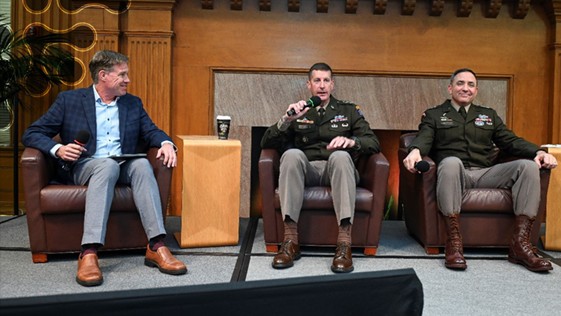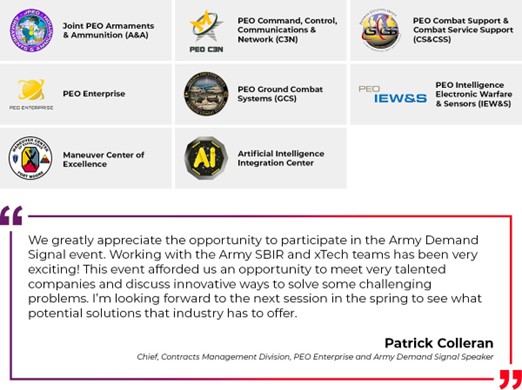

By Tara Clinton, Office of Army Innovation Programs
PALO ALTO, Calif. – Small businesses and technology innovators often find themselves unsure of the Army’s current and future technological needs. Recognizing this gap, the Army Demand Signal Forum was developed to foster better information sharing between its stakeholders and the innovation economy.
On Feb. 6, 2025, six Army program executive offices, two Army research centers, over 200 entrepreneurs, and several venture capitalists gathered at Stanford University in Palo Alto, California, for the Army Demand Signal Forum to integrate cutting-edge technology into the Army innovation ecosystem and drive impactful partnerships. Among the highlights of the event was the launch of the U.S. Army xTechIgnite competition, which offers a unique platform to outline critical Army technology needs while showcasing viable development pathways.
The Army Demand Signal Forum aimed to bridge the mutual gap between Army stakeholders and industry leaders in emerging technologies, including original equipment manufacturers, venture capital firms and entrepreneurs. The Army xTech and Army Small Business Innovation Research and Small Business Technology Transfer (SBIR|STTR) Programs collaborated with America’s Frontier Fund, Venrock, and Stanford’s Gordian Knot Center for National Security Innovation to address critical technology needs, capabilities and development of funding opportunities from an $800 million investment pool. The forum opened doors to transformative partnerships that drive innovation and shape the future of defense technology, offering stakeholders a unique opportunity to contribute to national defense and develop solutions that will impact defense capabilities for years to come.
“Many connections that were made have already begun panning out into fruitful new relationships… As an xTechPrime winner, Neurable deeply looks forward to attending forthcoming Army xTech events in the future.”
Avi Horowitz, Head of Product, Neurable Inc. (xTechPrime 2023 Winner)
Speakers included Gen. James E. Rainey, commander, Army Futures Command; Lt. Gen. Greg Anderson, commander, XVIII ; Lt. Gen. Joel Vowell, deputy commanding general, U.S. Army Pacific; Dr. Matt Willis, director of Army Innovation Programs, Office of the Assistant Secretary for Acquisition, Logistics, and Technology; and private sector leaders from Venrock, Lux Capital, NEA, BAE Systems and more. Eight Army Acquisition organizations provided demand-signal briefings, including:

xTechIgnite Competition
During the forum, the U.S. Army xTech Program launched the xTechIgnite competition, in collaboration with six Army PEOs in attendance, including JPEO A&A, PEO C3N, PEO CS&CSS, PEO Enterprise, PEO GCS, and PEO IEW&S. The competition highlighted critical Army technology needs identified by PEOs that align with technology solutions currently advancing in the commercial market, and will award up to $400,000 in cash prizes.
Up to 64 xTechIgnite finalists will receive $2,500 and an invitation to pitch their novel technology solutions to Army and Department of Defense experts. The Army will select up to 24 final winners, each eligible for a $10,000 cash prize and the opportunity to submit a Phase I or Direct to Phase II SBIR proposal through the Army SBIR Program, which will offer follow-on funding opportunities for up to $27 million for winners. The competition closed for initial submissions on March 12, 2025.
“The US military is a complex customer, and startup founders should engage early to understand their needs and how they go about adopting new technology. SBIRs are a fantastic method for a startup to formalize a relationship as a vendor, and use that as a starting point to execute on a strategy, developed by engaging prior with stakeholders such as those present at the Army Demand Signal event.”
Shahin Farshchi, Partner, Lux Capital and Army Demand Signal Forum panelist
A second Army Demand Signal forum will take place in June 2025, featuring the xTechIgnite Awards Announcement, technology briefings from entrepreneurs, and technology innovation needs from the Army research and development enterprise.
For additional information, please reach out to the U.S. Army xTech Program at Army xTech Program mailbox.
About the Army SBIR|STTR Program
Army SBIR continuously releases funding opportunities, including Phase I funding for commercially viable, feasible, and technically sound solutions. Firms with mature technologies meeting Phase I requirements can advance to Phase II or Direct to Phase II contracts. Throughout the process, technical, acquisition, and operational Army experts guide businesses to align their innovations with the Army’s critical needs.
Army STTR integrates small businesses in the Army innovation ecosystem by partnering them with universities, federally funded research and development centers, or qualified non-profit research institutions, with small businesses as the prime contractors. Small businesses must act as prime contractors, performing at least 40 percent of the work while research partners perform at least 30 percent.
The Office of the Assistant Secretary for Acquisition, Logistics, and Technology leverages innovative technologies to give Soldiers a decisive advantage in any environment by developing, acquiring, fielding and sustaining the world’s finest equipment and services. For more information, visit the ASA(ALT) web page and follow @ArmyASAALT.
About the Army xTech Program
Since its inception in 2018, the Army xTech Program has operated as a beacon of innovation, connecting participants directly with Army laboratories and decision-makers. It provides essential feedback, training, and networking opportunities. Committed to fostering groundbreaking solutions, the program hosts multiple competitions annually to ensure that business innovations align perfectly with Army needs.
Stay Updated
Subscribe to email updates or check back on the Army SBIR|STTR website. Follow us on Facebook, X (formerly Twitter) and LinkedIn. For inquiries, contact us at the Army SBIR|STTR mailbox.
Any references to commercial product or services is not, and shall not, be construed as official Army or DoD endorsement

